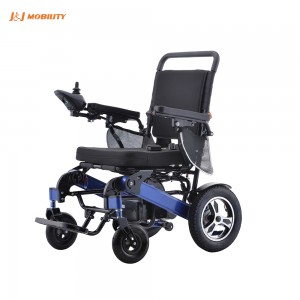Essential Information About Wheelchair Batteries
With technological advancements, battery-powered wheelchairs have become increasingly popular. As a key component of electric wheelchairs, batteries deserve close attention. This guide provides a comprehensive overview of wheelchair batteries, including their types, maintenance, and the benefits of using removable lithium batteries from J&J Mobility.
Why Battery-Powered Wheelchairs Are Gaining Popularity
1. Enhanced Mobility
Battery-powered wheelchairs, or electric wheelchairs, offer users significant independence by providing smooth, controlled movement. This ease of navigation helps users move freely in various environments.
2. Improved Quality of Life
Electric wheelchairs improve the quality of life by enabling users to engage in daily activities—such as shopping, socializing, and exploring—without relying on others. This independence boosts confidence and overall well-being.
3. User-Friendly Design
These wheelchairs are designed for ease of use. They typically feature intuitive controls, such as joysticks or simple buttons, making them accessible to users with limited physical strength or dexterity.
4. Technological Advancements
Modern electric wheelchairs benefit from advanced battery and motor technologies. Improvements include longer battery life, faster charging, and enhanced power and torque, contributing to better reliability and convenience.
5. Accessibility and Inclusion
The emphasis on accessibility and inclusivity has driven the popularity of battery-powered wheelchairs. Enhanced infrastructure and societal awareness empower users to participate more fully in social and recreational activities.
Types of Common Wheelchair Batteries
1. Sealed Lead Acid (SLA) Batteries
Sealed Lead Acid (SLA) batteries are commonly used in standard electric wheelchairs. Here are their pros and cons:
Advantages:
Safety: Sealed construction prevents the release of harmful gases.
Maintenance-Free: No need for regular electrolyte topping.
Cost-Effective: Generally more affordable than other types.
Long Shelf Life: Retain charge for extended periods.
Disadvantages:
Heavy: Lower energy density results in bulkier, heavier batteries.
Limited Cycle Life: Fewer charge-discharge cycles compared to other types.
Low Charge Retention: Gradual self-discharge over time.
Slower Charging: Longer charging times.
Environmental Concerns: Contains lead, which is toxic if not disposed of properly.
Airline Restrictions: Not allowed on planes.
2. Gel Batteries
Gel batteries, also known as gel cell or valve-regulated lead-acid (VRLA) gel batteries, are another type of SLA battery suitable for power wheelchairs and scooters.
Advantages:
Safety: Sealed construction prevents acid spills.
Deep-Cycle Capabilities: Designed for repeated discharges and recharges.
Vibration Resistance: Suitable for uneven terrain or frequent movement.
Maintenance-Free: Similar to SLA batteries.
Disadvantages:
Lower Energy Density: Heavier and may impact maneuverability.
Slower Charging Rate: Takes longer to charge.
Sensitivity to High Temperatures: Can be affected by extreme heat.
Cost: More expensive than traditional lead-acid batteries.
Airline Restrictions: Similar to SLA batteries.
3. Lithium-Ion (Li-ion) Batteries
Lithium-ion (Li-ion) batteries are increasingly popular in electric wheelchairs due to their advanced features.
Advantages:
High Energy Density: More energy stored per unit weight, allowing for a lighter and more compact battery.
Lightweight: Improves portability and maneuverability.
Longer Lifespan: Greater number of charge-discharge cycles.
Faster Charging: Reduced charging times.
Airline-Approved: Can be taken on planes, suitable for long-distance travel.
Disadvantages:
Cost: Generally more expensive, though prices are decreasing.
Safety Considerations: Requires careful handling to avoid issues such as overcharging or excessive heat.
How to Maintain Different Battery Types
1. Sealed Lead Acid (SLA) and Gel Batteries
Clean Regularly: Keep the battery clean and free from dirt, corrosion, and moisture. Inspect and clean terminals if needed.
Avoid Deep Discharges: Recharge promptly after use to prevent deep cycling.
Proper Storage: Store in a cool, dry place away from sunlight and extreme temperatures.
Disposal: Follow recycling procedures for old or damaged batteries. Contact local centers for proper disposal.
2. Lithium-Ion (Li-ion) Batteries
Follow Instructions: Adhere to maintenance guidelines provided by the manufacturer.
Regular Charging: Charge batteries regularly, even if the wheelchair is not in use.
Compatible Charger: Use a charger specifically designed for Li-ion batteries.
Avoid Extreme Temperatures: Keep within the recommended temperature range.
Inspect for Damage: Check for cracks, leaks, or swelling.
Clean Terminals: Ensure battery connectors are clean and free from debris.
Proper Storage: Follow guidelines for storage if the wheelchair will not be used for an extended period.
Proper Disposal: Dispose of Li-ion batteries properly when they reach the end of their life.
Why Choose J&J Mobility Electric Wheelchairs?
J&J Mobility offers electric wheelchairs with removable lithium batteries that provide several advantages:
Easy Charging: Batteries can be charged conveniently with the provided charger.
Air Travel Compatibility: Compliant with airline regulations, making it easier for users to travel by plane.
Lightweight and Compact: Enhances maneuverability and transportability.
Long-Lasting Performance: Provides consistent performance and longevity.
Understanding the different types of wheelchair batteries—whether Sealed Lead Acid, Gel, or Lithium-Ion—is essential for making an informed choice. Proper maintenance and choosing the right type of battery can significantly impact the performance and lifespan of your electric wheelchair. J&J Mobility’s removable lithium batteries offer added convenience and compatibility, making them an excellent option for users seeking a travel-friendly and efficient mobility solution.
Post time: Sep-11-2024


